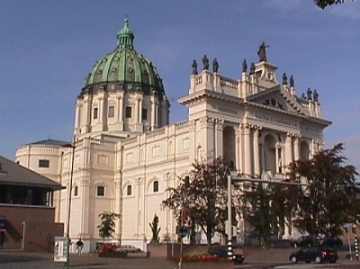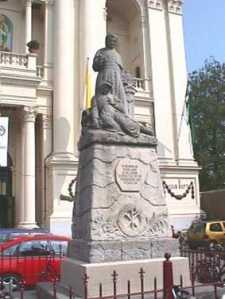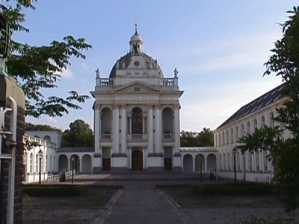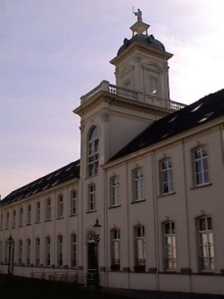
Oudenbosch, roughly situated between the cities of Breda and Roosendaal, is probably one of the most exotic looking places this country has to offer. Thanks to a local priest, the conservative father Willem Hellemons, the center of this village received a complete makeover. A new church was built, several catholic institutions and monasteries found a home here, resulting in a large catholic complex that gave Oudenbosch its nickname of "Vatican of the North". This page shows some of the most typical sights in Oudenbosch.
 Father
Willem Hellemons (1810-1884) had studied in Rome and had become
a friend of the pope. He intensely enjoyed the city and its architecture.
In 1834 he became assistant in the Oudenbosch parish, and finally
its priest in 1842. In those days Oudenbosch still had its old
church, dating from 1513. Although the old Gothic church had
been returned to the Catholics in 1799, in 1864 it was decided
that a new church was to be build. Hellemons decided it was to
become a copy of the St. Peter in Rome. P.J.H.
Cuypers, more famous for his neo-Gothic churches, designed
the new building. The church, named Basiliek
van de H.H. Agatha en Barbara ("Basilica of Saints
Agatha and Barbara") is a 1:3th scale copy of the St. Peter,
but its facade is inspired by the St. John Lateran and was added
in 1892 after a design of architect G.J. van Swaay.
Father
Willem Hellemons (1810-1884) had studied in Rome and had become
a friend of the pope. He intensely enjoyed the city and its architecture.
In 1834 he became assistant in the Oudenbosch parish, and finally
its priest in 1842. In those days Oudenbosch still had its old
church, dating from 1513. Although the old Gothic church had
been returned to the Catholics in 1799, in 1864 it was decided
that a new church was to be build. Hellemons decided it was to
become a copy of the St. Peter in Rome. P.J.H.
Cuypers, more famous for his neo-Gothic churches, designed
the new building. The church, named Basiliek
van de H.H. Agatha en Barbara ("Basilica of Saints
Agatha and Barbara") is a 1:3th scale copy of the St. Peter,
but its facade is inspired by the St. John Lateran and was added
in 1892 after a design of architect G.J. van Swaay.
In front of the basilica stands this monument for the 3000 zouaves from the Netherlands that fought to defend pope Pus IX against Garibaldi's troops between 1864 and 1870. Father Hellemons played a major role in the recruitment of these catholic volunteers, and many of them gathered in Oudenbosch before heading for Italy. Even though they had fought for a lost cause, after the war zouaves were among the most respected citizens in many towns and villages in Noord-Brabant, and a museum devoted to this obscure part of this country's history is located near this church.

Perhaps not as impressive as the basilica, but certainly as exotic, is the complex of the Instituut Saint-Louis, a former boarding school for catholic boys, of which we here see the chapel, which in its turn is a scaled down version of the basilica.

The former boarding-school itself has been rebuilt into apartments.